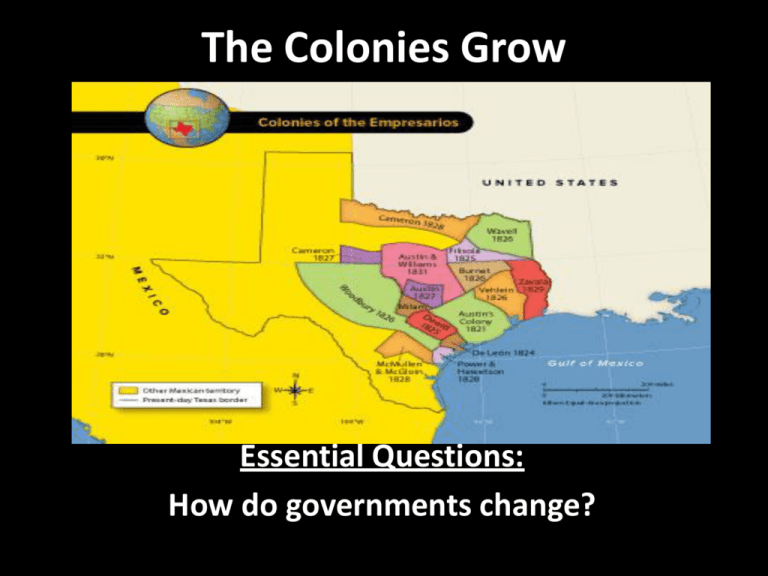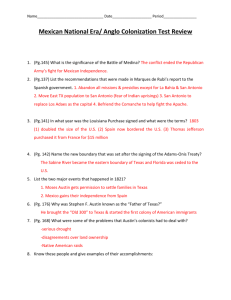Mexican Texas: Empresarios & Colonization (1821-1836)
advertisement

The Colonies Grow Essential Questions: How do governments change? Mexican Rule and Colonization • Mexican National Era – Began in 1821 with Mexican Independence • During this period, Texas was part of Mexico, and the Mexican government attempted to control the settlement of Texas. Mexico’s Government and Constitution • Agustín de Iturbide declared himself emperor of Mexico (May 19, 1822 – March 19, 1823) • Federalists (who believed in a weaker central government that shares power with the states) formed a new government. • The Centralists opposed the new government. They believed that the central government should be stronger than the states. Mexico’s Government and Constitution • According to the Mexican federal Constitution of 1824, Mexico would be divided into 19 states and 4 territories. Two former Spanish provinces, Coahuila and Texas, were united as the Mexican state of Coahuila y Tejas. • Baron de Bastrop would represent Texas. New Colonization Laws (1824) • Allowed states to make decisions about issuing land grants (Federalism) • Some restrictions for colonization were given: – Land grants could not exceed 48,708 acres per person. – Colonies could not be established too close to the coastline or an international boundary without the government’s permission. – Become permanent residents of Texas to receive land. • People only had to make their way to Saltillo, the capital of the state of Coahuila y Tejas, to receive contracts. (Before: had to travel to Mexico City) The State Colonization Law of 1825 • In the hope of increasing the state’s population, the state legislature in Saltillo made rules designed to attract settlers. • Settlers in Texas could gain titles to land by themselves or through empresarios. • A family could obtain up to 4,428 acres of land for just $30. • Colonists would not have to pay general taxes for a set amount of time. • Most single men would receive 1,107 acres of land. Another 3,321 acres would be given to them when they married. A man who married a Mexican woman would receive a bonus of an additional 1,107 acres. The State Colonization Law of 1825 • Requirements: – Colonists to have good moral character. – They also had to be Christian, and that was understood to mean Catholic. • Benefits of using empresarios – Knew the Spanish language or had translators – Knew how to go about receiving claims to the land – Held the best lands • Empresarios received: – 23,000 acres of land for every 100 colonists they settled in Texas (Had six years to settle 100 colonists) Austin’s Many Colonies • 1st Colony Contract: Bought over 300 families (Old Three Hundred) – San Felipe de Austin was founded as the colony’s unofficial capital. Austin’s colony became the most successful Anglo American colony in Texas. More Contracts for Austin • 2nd Colony Contract: 1825 – Austin agreed to bring 500 new families to settle within his original colony • 3rd Colony Contract: 1827 –100 families to live east of the Colorado River and north of the San Antonio Road. “Little Colony,” as it was called, made its headquarters in the town of Bastrop. • 4th Colony Contract: 1828 –300 families and special permission to establish a colony along the coast. • 5th Colony Contract: 1831 – Austin and his partner Samuel M. Williams received permission for one more contract, which turned out to be Austin’s last. (800 families) Austin’s Success • Fortunate timing • Good leadership – Speak Spanish – Knowledge of how to do business with governments • Excellent land • Plentiful wood • Access to water Other Empresarios • By 1833, the population of Texas was estimated at around 20,000. • Land in Texas was cheap compared to the United States. (10 acres for the price of 1) • Many Americans believed that the United States would someday buy Eastern Texas from Mexico. Green DeWitt (Gonzales) • April 1825 – Green DeWitt and his partner James Kerr were granted permission to settle 400 families on property next to Austin’s original colony (Gonzales) • Late into DeWitt’s six-year contract, Mexico passed the Law of April 6, 1830, which limited immigrants entering Texas. (1831- Gonzales had 531 people) Green DeWitt (Gonzales) • Difficulties – Never became a commercial center or built a church; no school until 1831 – Sara DeWitt (wife) petitioned the government to grant her land in her own name to protect the family from poverty (one of few grants made to a woman) – Green DeWitt died in 1835 (probably of cholera, dehydration) • In spite of all its difficulties, the DeWitt colony is considered one of the most successful Anglo American colonies in Texas. Martín De León (Victoria) • Mexican native - De León’s colony was the only Texas colony settled mainly by Mexican families • In 1824, they founded the town of Victoria (over 100 families) and built both a school and a church • De León was a cattle rancher who was known for giving beef to Native Americans in hopes of easing tensions with them (Capitán Vacas Muchas, or “Captain Plenty of Cows”) • Like DeWitt, Martín De León became ill with cholera, and he died in 1833. Stories of Success • Irish immigrants (Refugio and San Patricio) • Empresarios and the settlers they brought contributed their time, energy, and resources to make Texas what it is today. 1. Why is the period of Texas history that included the settling of the area by empresarios called the Mexican National era? • Texas was part of a state in the nation of Mexico at the time. 2. Identify the effects of the Mexican federal Constitution of 1824 on Texas. • Coahuila y Tejas formed; a high population could allow Texas to be a state; Texas given state representation 3. How did Mexico’s State Colonization Law of 1825 reflect the ideas of the Federalist government? • It allowed individual states to write their own laws 4. Identify the factors that made Stephen F. Austin a successful empresario during the settlement of Texas. • Austin had good timing, strong leadership skills, and experience with government officials. He could speak Spanish. 5. What groups settled Texas under the empresarios? Why did they come? • Many Anglo American settlers came from the southern US; some came from Ireland. They wanted cheap farmland and thought it would be a good investment.







